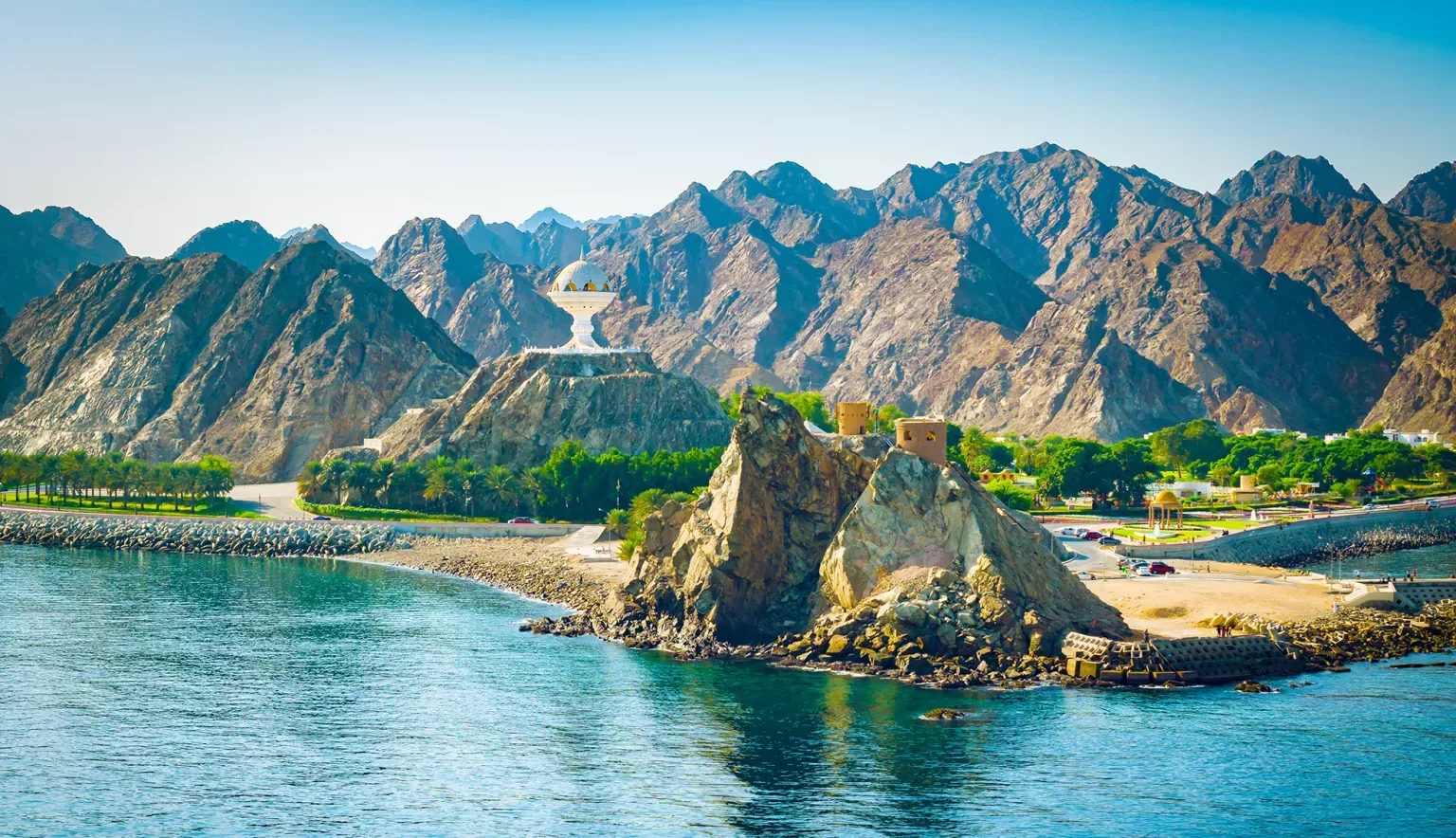Oman is one of the Middle East’s most peaceful and welcoming countries, with craggy mountains, windblown deserts and endless beaches.
OMAN
During the rule of Sultan Qaboos (1970 to 2020), Oman was transformed from an internationally isolated country with just five kilometres of asphalt road to a peaceful, developed society. It’s now a Sultanate where a modern way of life is juxtaposed with a traditional, welcoming Bedouin culture. Tourist arrivals have doubled in the past decade, with more than 3.5 million tourists visiting in 2019.
Oman is a country of vast, rugged panoramas. Its craggy mountains soar to heights of 3,000 metres. Rub’ al Khali (the ‘Empty Quarter’) is a desert of undulating red-gold dunes, covering 650,000 square kilometres. There are areas of Oman’s coast where you can drive down endless beaches, stopping to camp on a deserted stretch of sand. People take camel rides, 4WD trips and even cycling excursions across these expanses.
The country also has an abundance of luxury lodgings, from five-star desert lodges to mountain hotels with infinity pools facing the peaks. Much of this accommodation is located on the Musandam Peninsula, which is nicknamed the ‘Norway of Arabia’ thanks to its dramatic limestone mountains and deep glassy fjords.
The country also has a fascinating culture. The capital, Muscat, boasts a bustling souq, some absorbing museums and the Sultan Qaboos Mosque – an example of modernist Islamic architecture at its most lavish. The rocky landscape is speckled with ancient defensive forts. One of the most famous is Nizwa Fort, built in the ninth century with an imposing cylindrical tower, a labyrinth of passages and rooms, and views of the mountains from the ramparts. Oman is a compelling blend of the traditional and the contemporary.
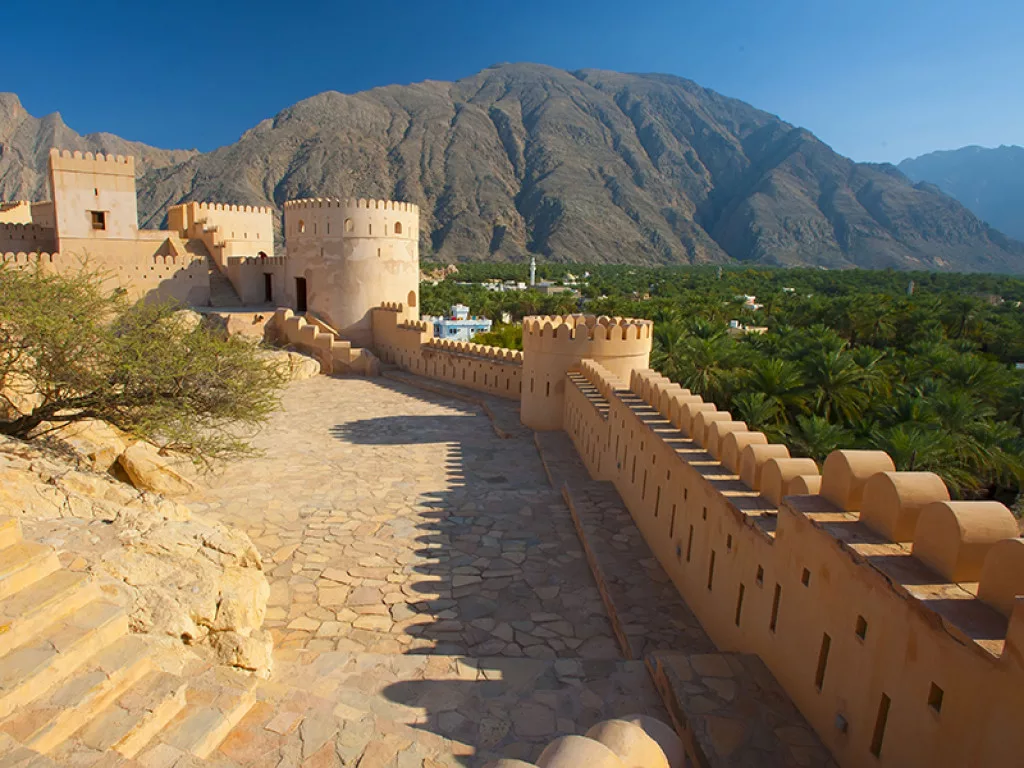
TOURISM INSIGHTS: THE MINISTRY OF TOURISM OMAN
The Ministry of Tourism aims to promote Oman as luxury tourist destination. Its vision: to provide efficient and effective services for Oman to become a top holiday and MICE destination by 2040, attracting 11 million tourists annually.
We caught up with Salem bin Adi Al Mamari, Director General of Tourism Promotion, to find out more.
Q&A WITH SALEM BIN ADI AL MAMARI, DIRECTOR GENERAL OF TOURISM PROMOTION
How do you market and promote Oman?
Salem bin Adi Al Mamari (SM): Oman’s brand creates a united identity for an otherwise very diversified and attractive product. It is our belief that branding has enabled Oman to become and remain an enhanced environment for tourist attractions and investments.
“Beauty has an address…” Oman’s brand strapline, is not a marketing soundbite – it has a much deeper meaning than that. It explains the essence of Oman; four simple words that set us apart from our peers. Beauty is what Oman offers for its residents and visitors. In addition, it encompasses the Sultanate’s ancient history, spirit and pursuit of development. The national brand has also inspired government agencies, communities, organisations and businesses that live, work and engage with Oman.
The bold brand mark is a mélange of the best Oman has to offer. Expertly crafted, the mark draws on a rich and vibrant colour palette which reflects Oman’s natural beauty. It’s inspired by the wonderful diversity that is Oman, such as Arabic calligraphy, marine exploration, local textiles and of course frankincense, which has been at the core of our culture and economy for generations. Looking right to left, the brand mark can be interpreted as the sail of a dhow (purple), the turtle and rich marine environment (marine green), mountain terrain (light blue) and frankincense (light green).
What are your organisation’s current goals?
SM: We have several current important goals. For a start, we wish to increase Oman’s visitors from the GCC and promote Oman as a luxury destination, alongside promoting close cooperation between the government and the private sector.
We also wish to create community awareness, understanding and support for tourism development, as well as enabling more Omani citizens to reap the economic benefits of tourism, either through direct employment, conservation of heritage or investment in communities.
How are you aiming to develop ecotourism in the country?
SM: The Government of Oman (represented by the Ministry of Tourism) is focussed on making sure that tourism develops in an environmentally friendly manner, so that the environment is preserved for future generations.
Nature reserves are distributed throughout the Sultanate of Oman, from the Al Quram Trees Reserve in Muscat governorate to the Land of Frankincense reserve in Dhofar. The experience of watching turtles nesting throughout the night at the Scientific Center and Ras Al-Jinz Reserve in Sur is the perfect scientific tourism experience. It is worth mentioning that the Ras al-Hadd, which is a part of Ras al-Jinz Reserve, is the spot where you can witness the first sunrise in the Arab world every day.
In addition, Oman is a seasonal destination for migratory birds. An estimated 300 species can be seen throughout the year on Masirah Island and other locations. Regular dolphin watching cruises depart from the Musandam governorate in the far north, Muscat, and the Dhofar governorate in the south, while in Al-Wusta governate you can see Arabian Oryx, deer, desert foxes, Nubian and desert cats.
Are there any interesting projects in the pipeline you wish to highlight?
SM: Yes, we have lots of exciting projects. Madinat al Irfan is the result of an exciting ambition to establish a new urban centre within Muscat. Situated near the new Muscat International Airport and enjoying excellent transport connections to the capital area and beyond, Madinat al Irfan will create a new downtown area for residents, businesses and visitors. With Wadi Park as its spine, Irfan will be a city with public space at its heart. Madinat al Irfan will become an exemplar both locally and regionally, providing a model for urban development. Importantly, Madinat al Irfan will also become a catalyst for change in Oman; setting new benchmarks in terms of sustainability and urban design, providing public transport while creating a magnet for business, a centre for tourism and a great place to live and work.
Sultan Qaboos Port is a regeneration initiative that will connect the Muscat of yesterday with the vision of its tomorrow. The existing commercial port will be transformed into one of the region’s primary waterfront destinations and the capital’s tourism and economic gateway. It’s located in the Muttrah district, which has one of the oldest traditional souks in the Arab world. The waterfront will be transformed into a vibrant, active and high-quality public realm, while integrating and the natural historical surroundings and blending the traditional Omani aesthetics and heritage.
Why, in your opinion, should someone visit Oman?
SM: Sharing borders with the UAE to the northwest and Saudi Arabia to the west, Oman is a breathtakingly beautiful country with unique adventures that will captivate travellers. As any tourist can attest, the blend of the old and the new in this part of the world is incredibly seamless.
Omani people are immensely proud of their ancient, frankincense-trading past as well as their unique traditions and culture. They have a strong sense of identity and love for country. While they preserve their heritage, they also embrace modern ways and new thinking. The capital Muscat, for instance, is home to big shopping malls frequented by many citizens and residents alike. Fancy hotels and restaurants offering a wide range of cuisines, from budget-friendly to the most expensive, have dotted the city.
Also situated in Muscat is one of Oman’s most loved treasures, the must-visit Sultan Qaboos Grand Mosque. Located on the other side of Muscat, Mutrah Corniche offers strollers the stunning view of the lovely seafront. The famed Rocky Mountains are the perfect backdrop for the corniche’s white buildings, mosques, and forts. Nearby is one of Oman’s oldest markets, the Mutrah Souq, where stalls sell frankincense and myrrh, incense burners, silver jewellery, turbans, and traditional lamps.
What makes the Sultanate stand out are its spectacular mountains, windblown deserts, stunning wadis, and a pristine coastline. Its many old mud hut villages, though most are now abandoned and in ruins, intrigue tourists. Misfat Al Abriyeen is one of the few ancient villages in the country that is still inhabited.
Additionally, Oman provides adventures in the rolling dunes of Sharqiya, the rocky mountains around Nizwa, and the sandy beaches of Sur. Forts and castles are among the country’s popular attractions. Built in 1670, Jabreen Castle resembles a sandcastle established in an oasis of date palms. Nizwa Fort, on the other hand, is popular for its massive circular tower.
The storied Bimmah Sinkhole is another must-visit place, especially for adventurers. Legend has it that the cavernous Bimmah Sinkhole was formed by a meteorite called Hawaiyat Najm, or ‘The Falling Star’. When the limestone rock collapsed in on itself, a 131-foot-wide and 65-feet-deep crater in the coastal desert of Northern Oman with an aquamarine pool at the bottom was revealed.
There are many reasons to visit Oman. Exploring the Sultanate always leaves an imprint on visitors, who, after their unforgettable tour of the country and memorable experience, always come back for more.
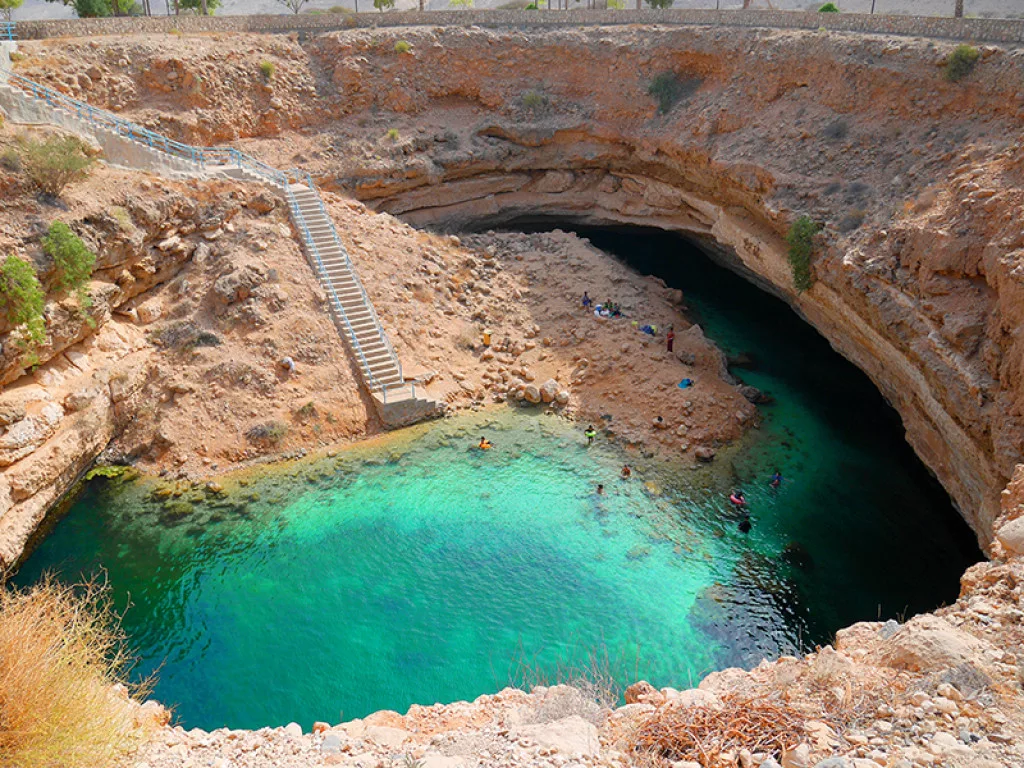
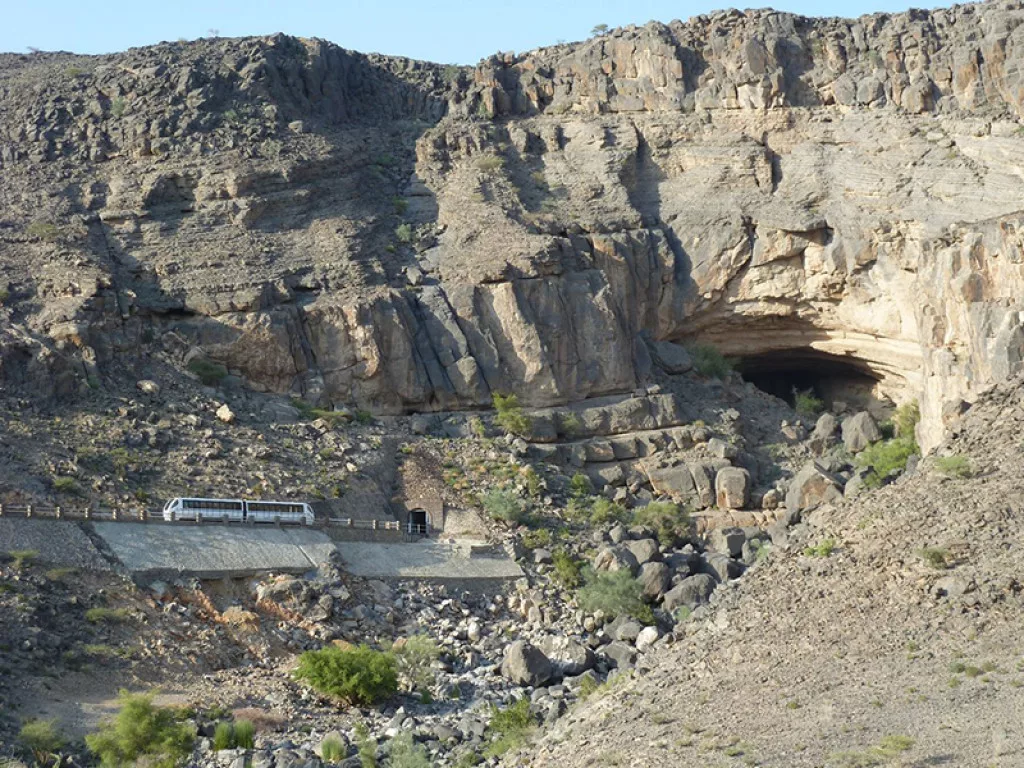
What are some of the country’s most unique landmarks?
SM: Our most famous landmark and principal place of worship is the Sultan Qaboos Grand Mosque, created using the finest craftsmanship and materials. Within the Main Prayer Hall, the pulpit overlooks space for a congregation of 7,000 people. They sit on what is considered to be one of the world’s finest Persian carpets in an area illuminated by Swarovski crystal chandeliers, reflecting the appearance of the mosque’s minarets. These minarets act as a reminder of the five key elements of Islam: reciting the Muslim profession of faith; praying five times a day; giving to charity; fasting during the month of Ramadan; and, if possible, undertaking the Hajj pilgrimage to Mecca.
The National Museum is the Sultanate of Oman’s flagship cultural institution dedicated to Oman’s cultural heritage, showcasing Oman’s history from the earliest human settlement in Oman Peninsula some two million years ago to the present day, as well as offering glimpses into our future.
The Royal Opera House is the first of its kind in the Gulf States with over 1,000 seats in its main hall, occupying an area of 80,000 square metres and set among swathes of beautiful landscaped gardens – it opened in October 2011. The design combines modern and traditional Omani styles, boasting impressive decorative lighting and breath-taking sculptures. Musical, operatic and dance performances from local and international artists are staged here, establishing Oman as the classical music epicentre of the Gulf States.
What challenges does the tourist industry in Oman face?
SM: One challenge we face is the instability of the political situation in the Middle East. The limited network of Oman airlines, especially the absence of direct flights from and to the global tourism markets targeted by the Sultanate, is another challenge.
Finally, some local communities do not accept tourism, and citizens are not always interested in working in the tourism sector.
Are you optimistic about the future of the tourism industry in Oman?
SM: Despite the challenges, we remain optimistic. Tourism will bring additional economic prosperity, benefit the people of Oman and enhance its nature and culture. Oman is committed to economic diversification to move away from an oil-based economy. Tourism offers an enormous opportunity for achieving this major objective. Tourism will bring five important socio-economic benefits: increased employment; mobilisation of investment; a contribution to the country’s GDP; development of local economies and tourism SMEs; and improved quality of life and confidence in the future.
As tourism grows, host communities throughout the Sultanate will benefit and their lives will become fuller and more prosperous as they develop new skills, find better jobs and set up enterprises throughout the country.
Tourism will also help preserve Oman’s precious cultural and natural assets and reinforce cultural expression, strengthening the local pride and identity of the Omani population. It will strengthen the national brand, telling the world that Oman is an open, friendly, stable and peaceful place to visit, do business and invest.
MUSCAT IN FOCUS
Oman’s capital, Muscat, offers you everything you could want from a city break – a great dining scene, fascinating cultural attractions and easy access to beautiful natural spaces. Located on the coast, it’s surrounded by beaches. Many of the city’s luxury hotels have oceanfront access – the Al Bustan Hotel’s private beach is the longest in the country, offering opportunities for kayaking, snorkelling and sailing.
In Muscat, you’ll be perfectly placed to find out more about the region’s culture. Head to the National Museum opposite the Sultan’s Palace for interactive, well curated displays about Omani history. Bait Al Zubair is a popular private museum, showcasing Omani handicrafts and furniture in a restored traditional house.
Mutrah is one of the city’s most popular neighbourhoods. Stroll down the corniche, looking at the traditional dhows bobbing in the ocean beyond. You’ll love shopping for souvenirs at the bustling souk, where you’ll find an array of products from across the world – local frankincense, handmade Omani hats, embroidery from Kashmir and Nepalese jewellery.
In the evening, the city’s forts and palaces are illuminated. Enjoy dinner and drinks at one of the city’s many outdoor restaurants, overlooking the ocean.
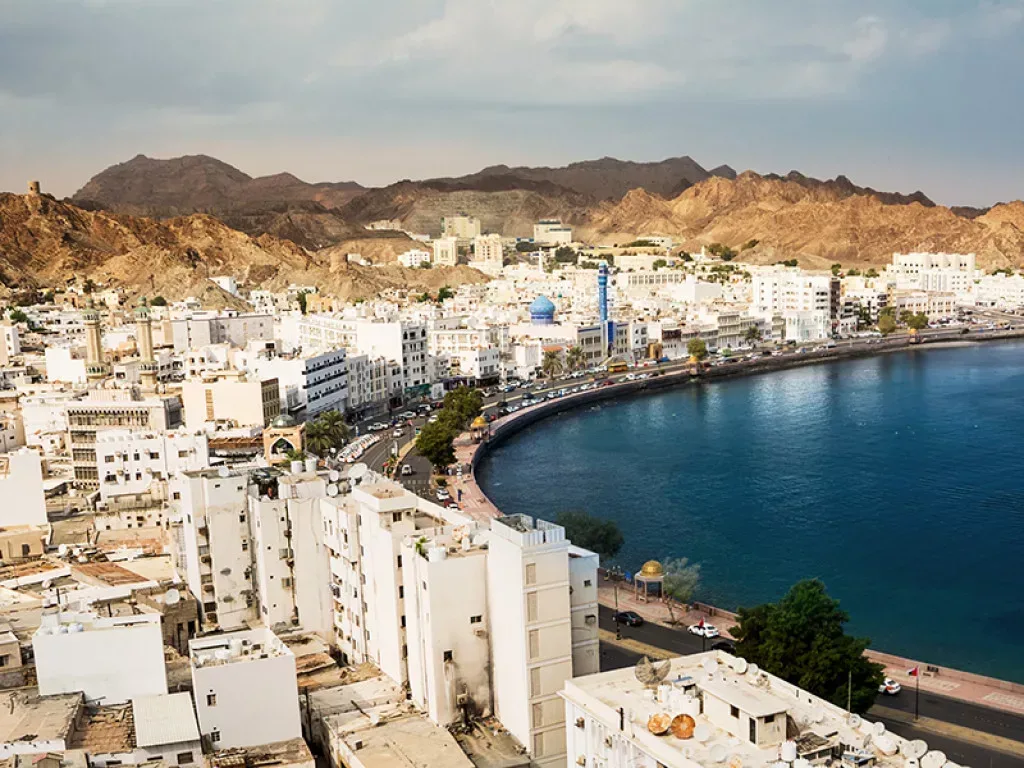
OUTLOOK RECOMMENDS
Eat:
For succulent seafood and ocean views…
For high-end Omani cuisine…
Sleep:
For beaches, mountains and minimalist elegance…
For luxury surrounded by desert dunes…
Thousand Nights Camp, in the heart of the Eastern Omani Sands, was recently awarded ‘World’s Best Luxury Desert Camp’ at the Luxury Hotel Awards. You’ll stay in deluxe Bedouin tents and experience a mixture of high-class service and authentic experiences, such as music performances and a ‘shua’ meal.
For high-end heritage stays in Muscat…
For superior hospitality in Nizwa…
Al Diyar Hotel is renowned for its excellent service and comfortable, air-conditioned rooms. It offers two outdoor pools, free Wi-Fi, a cosmopolitan restaurant and a conference centre. It’s located a six-minute drive from historic Nizwa souq.
Fly:
Oman Airports is a government-owned company that manages and operates the civil airports in the Sultanate of Oman, providing on-ground services, terminal buildings, cargo buildings, runways, aprons, car parking and other facilities. Oman’s airports connect to 79 cities worldwide and see traffic of 17.7 million passengers.
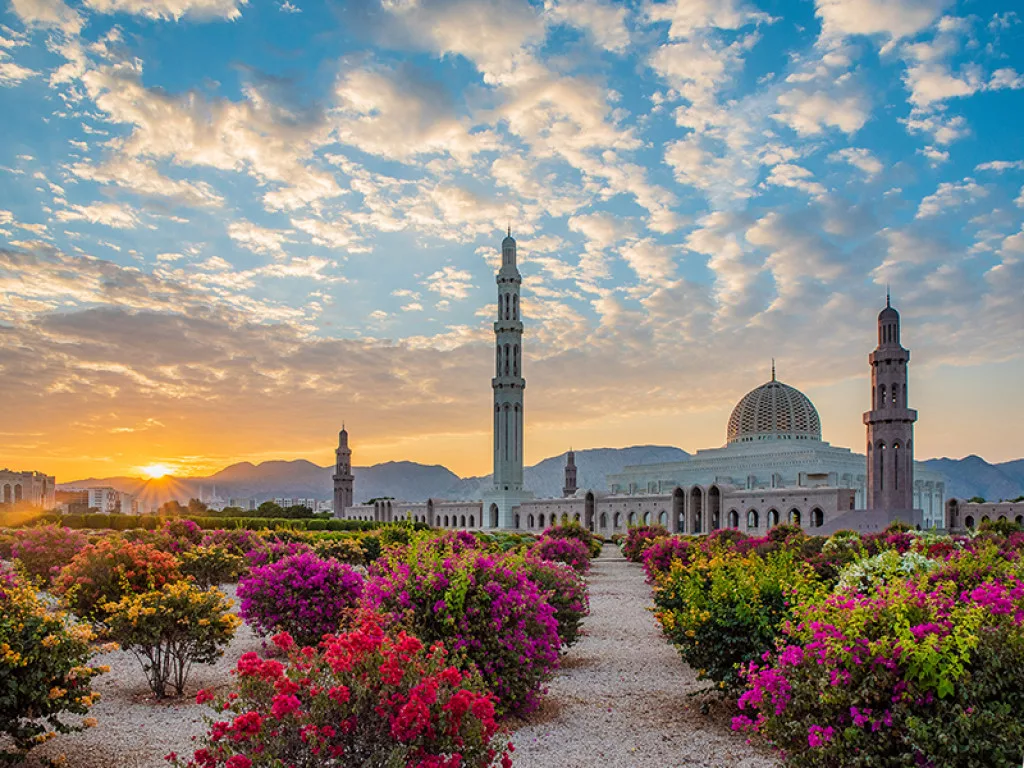
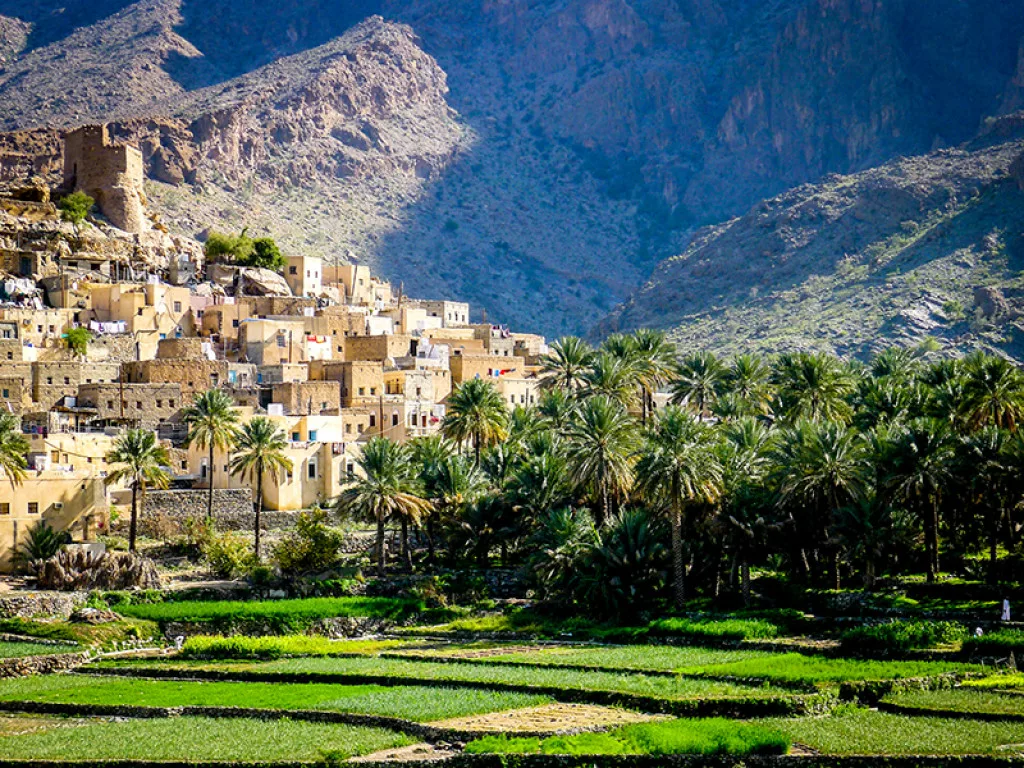
LANDMARK ATTRACTIONS
Al Hoota Cave
This cave is the only one in Oman developed for tourism; a series of ambiently-lit caverns studded with stalagmites and stalactites. Visitors are transported inside on a narrow-gauge railway and make their way along an 850-metre trail through the atmospheric interior.
Empty Quarter Viewpoint
From this viewpoint, at the beginning of the Empty Quarter, you’ll see a sand corridor with dunes rising up dramatically on either side; their summits undulating all the way to the horizon. You’ll be blown away by
the views of the world’s largest sea of sand.
Sultan Qaboos Grand Mosque
Sultan Qaboos gifted this mosque to the nation after 30 years of rule. It’s an imposing piece of modern Islamic architecture, with golden domes, arches and engraved walls. Inside the cavernous prayer hall you’ll find a gorgeous hand-loomed Iranian carpet, measuring 70 by 60 metres.
Fort Nakhal
This is one of Oman’s most famous forts, built in 1834 during the reign of Imam Said Bin Sultan on the remains of an ancient, pre-Islamic structure. Interesting features include circular towers to hold firm against cannon fire, and spiked doors to prevent being battered open. There are stunning views from the ramparts over the surrounding plains.
Balad Sayt
Balad Sayt is a small, unspoiled mountain village that sees very little tourist traffic. It’s blessed with a spectacular location in between the mountains of Ad Dakhiliyah and Al Batinah regions. The mountainous location means it attracts adventure tourism fans.
Royal Opera House
The Royal Opera House, located in Muscat, serves as the sultanate’s premier arts and culture organisation. As well as hosting performances from around the globe, it also offers an outreach programme alongside dining and shopping facilities.
Mutrah Souk
This bustling indoor souk in Muscat is the perfect place for people watching and souvenir shopping. Stalls display an array of handicrafts and jewellery from Oman and further afield.
GETTING THERE AND AROUND
Most travellers will reach Oman by flying into Muscat International Airport, the largest and busiest in the country. It operates 71 direct flights to 31 different countries in Africa, Europe, Asia and the Middle East. Passengers from Oceania can reach the country by transiting through Bangkok, while tourists from the Americas can transit through European transport hubs such as London Heathrow and Paris Charles de Gaulle.
It’s possible to travel domestically by air – Oman has airports in Salalah, Duqm, Sohar and Khasab. However, many tourists prefer to hire a car to travel between Oman’s landmarks, taking in the desert landscapes. The Sultanate’s roads are sealed and of an excellent quality, making driving enjoyable.
Oman also has a reliable network of air-conditioned buses, operated by Mwasalat. They travel between and within cities. Many larger towns and cities, such as Muscat, also operate metered taxis.


